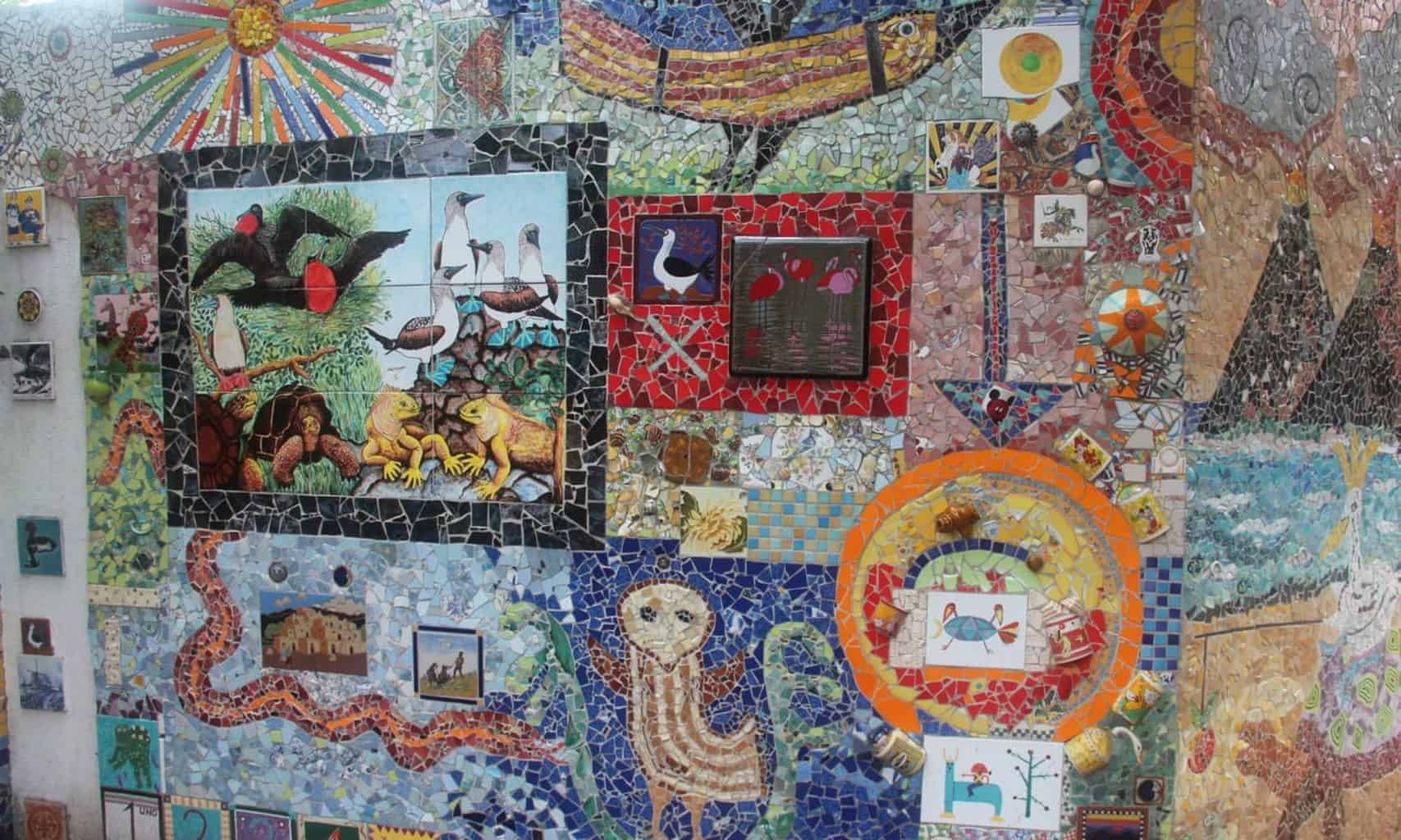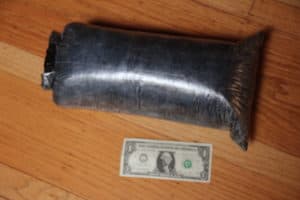Packing for your Camino walk
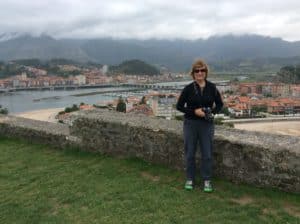
From reading the Camino forums or hearing questions at the talks that I give, I know that many people want to know what to pack for a pilgrimage walk. You’ll find my list below.
Having walked thousands of miles on Camino routes, and on backpacking trips in America, I pretty much know what works for me. What I pack is based on four factors — personal preference, anticipated weather, availability of accommodations, and that we carry our own packs.
Personal preference means, for example, that I bring my (very light-weight) down sleeping bag instead of a sleep sheet or similar because I like having my own bedding.
Anticipated weather means that I bring good rain gear because I have experienced drenching rain (particularly in the spring) and don’t like hiking in soaking wet hiking pants.
Accommodations includes not only rooms, but also places to find food and drink such as bars and restaurants. These are generally easy to find on the Frances, and harder to find on other Camino routes. When you won’t have places to stop during a day’s walk, you need to be self-sufficient and be mindful of where you can find shelter or get help. This is the second reason I bring my sleeping bag.
Likewise, we carry all of our own gear — not only because of personal preference, but also because transport services are not available on many of the alternate Camino trails.
We have always taken our Camino hikes in spring or fall — April, May, early June, or September and October. We have encountered snow, rain, and hail on some trips during April and May. We avoid mid-summer — late June through late August — because that’s when more Europeans are on vacation, and to avoid the heat. We’ve not gone during the winter because the usual weather makes it harder, and because fewer accommodations are open.
However, different people have different comfort levels, or are hiking under different conditions, so they may make other choices. Keep in mind, however, that for every person who thinks they brought too few items, there are probably a hundred who find they brought too much and look for a way to reduce pack weight.
Don’t pack based on your fears — have confidence that you can rise to meet the challenges. Also keep in mind that the Camino Frances (and most of the other pilgrim routes) travel through first-world countries — essentials are readily available.
Packing Lists: Condensed version (details and explanations follow)
Shoes: Altra Lone Peak, 1 lb. 7 oz.
Socks: Tilley 1 oz. x 3 = 3 oz.
Backpack: Osprey Tempest 40. 2 lbs.3 oz.
Rain gear: Goretex rain jacket 11.5 oz.,
Marmot Precip, full-zip rain pants, 11 oz.,
Hiker Umbrella: 6.5 oz,;
Pack cover: 3 oz.
Sleeping gear: Sleeping bag. Z Pack. 12.5 oz.
Trekking poles: Black Diamond. Carbon fiber 10.2 oz.
Hydration equipment: Water Bladder, 3 oz.
Toiletries: (Comb, lipstick, Glide (mini), sunscreen, chapstick, razor, toothpaste and floss. Shampoo, hair conditioner, hand lotion, and soap (hotel size), sunglasses and prescription eye glasses). Details vary, but I allow 8 oz.
First aid kit: I allow 1 lb.
Little things: I allow 1 lb.
Writing paper and pen, 1.75 oz.
Book, paperback,7 oz.
Headlamp, 3 oz.
Campsuds, large safety pins and/or clothespins,1.3 oz.
Clothing includes what I am wearing (“skin out”)
Hiking pants (synthetic) 7.75 oz.
Tee shirts, short sleeved. (2) 9.5 oz
Shirts, long-sleeve with UPF protection (2) 11 oz.
Smartwool, quarter zip, long sleeved top, 7.5 oz
Sunday Afternoons sun hat, 3 oz
Skirt, 6.4 oz.
Neckscarf .5 oz;
Bra (1), Panties (3) Total: 4 oz.
Full slip, nylon, black, 3 oz.
Down jacket 12.5 oz.
Gloves, fleece (or wool), 1.5 oz.
Hat, fleece, 2 oz.
Subtotal: 256.4 oz/16 lb.
Optional items:
Smartwool bottoms 5 oz.
Sandals (Mephisto) 1 lb., 1.5 oz
Camera: Canon SLR camera 2 lb.,7 oz
Subtotal: 3 lb. 9 oz./61.5 oz
Total regular and optional: 19 lb. 9 oz.
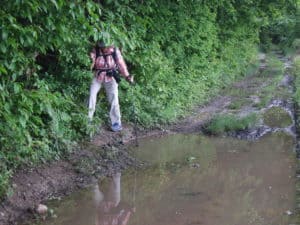 What and Why
What and Why
Footwear: Trail runners. An item to wear, not pack. One of the most controversial gear questions out there! For many years, I have favored Altra Lone Peak, 1 lb. 7 oz. I have often chosen men’s hiking shoes because of the greater width. Altras offer adequate cushioning, support, good grip, and wear.
I stopped wearing boots after suffering for weeks with pain because of my bunions while on the Camino Frances in 2001. It’s generally advisable to buy shoes 1/2-1 size larger than you normally wear because your feet will probably swell from the day-after-day walking on hard surfaces, the heat, and friction. Some boots need a break-in period and the Altra’s zero-drop style (no raised heel) sometimes takes a bit of time to get used to. Just be sure that your shoes are comfortable before you start your trip.
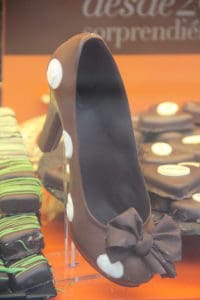
I also bring sandals. Fancier and heavier than they need to be, but I love my black suede Mephistos for going out. They are definitely in the “Luxury” category (see below).
Socks: Tilley Travel. My socks seem to vary with my mood and whether I expect much rain, cold, or heat. Tilley socks are synthetic, dry quickly and are lightweight, which is suitable for wearing with trail runners or sandals. When I expect cold or rainy days, I often change to double-layer Wrightsocks. 3 pr. Tilley 1 oz. x 3 = 3 oz. And currently, I am trying out and enjoying Darn Tough socks, which come in various weights, materials, and type. Bonus–they have a lifetime guarantee!
Backpack: Osprey Tempest 40. I carry my pack — not ship it ahead. Though there are bag-carrying services on the Frances, and increasingly other routes, we are often on less-traveled routes. I like being self-sufficient. 2 lbs.3 oz. Spray pack with Permethrin before trip.
Rain gear: Goretex rain jacket 11.5 oz., Marmot Precip, full-zip rain pants, 11 oz., hiker umbrella 6.5 oz,; pack cover 3 oz.
An alternate choice is a Packa (11.5 oz.) instead of a poncho (10.5 oz) and a pack cover (3 oz.).
We hike spring and fall and anticipate rain in the spring. Ponchos don’t provide full coverage. Wet pants’ legs are no fun!
Trail runners dry quickly (especially when stuffed with newspaper or dried using a hair dryer).
Trekking poles: Black Diamond. Carbon fiber (2).Collapsible Total 10.2 oz. Mine are not adjustable, but I have found that I don’t need them to be, and have never had the patience to be adjusting my poles anyway. They should have rubber tips for in town—though they don’t last long!
Hydration equipment: Water Bladder, 3 oz., and usually a plastic soda bottle that can be refilled.
Toiletries: Comb, lipstick, Glide (mini), sunscreen, chapstick, razor, toothpaste and floss. Shampoo, hair conditioner, hand lotion, and soap (hotel size), sunglasses and prescription eye glasses. Details vary, but I allow 8 oz.
First aid kit: Swiss Army knife (The Classic SD has tweezers, blade , toothpick, scissors, nail file with screwdriver, .74 oz.), headlamp, whistle, Mylar emergency blanket. Aspirin, ibuprofen; acetaminophen (Tylenol), Omnifix and Medipore for taping feet; hand sanitizer; Neosporum (antibiotic); Lotrimin or Cortisone (anti-fungal); Pepto Bismol and Imodium tablets; prescription meds. Optional: vitamins (check with doctor); energy/protein bars (2-4); Once again, details vary, but I allow 1 lb.
Laundry: Campsuds (transferred to small container), large safety pins and/or clothespins, 1.3 oz.
Little things: Pilgrim scallop shell; around-the-waist money belt (cash, passport, credit and ATM card, emergency numbers); bandanna; PacTowel; partial roll of TP and a few Ziplock bags; mosquito repellent (DEET or other). Optional: Lightweight bag for visits to the grocer — many charge .10 or more per plastic bag. I bring a nylon grocery bag on board our flight loaded with unread magazines. I leave the reading material behind at the end of my flight, but keep the bag for the visits to the grocery. Cotton gloves (sun protection). I allow 1 lb.
Clothes: The key with clothes is to mix and match. For example: all shirts go with all pants or skirts.
• Daywear: One pair hiking pants (synthetic) 7.75 oz. (Optional: zip-off 12 oz.); tee shirts (2) 2 x 4.75 oz. = 9.5 oz.; long-sleeve shirts with UPF protection (2) 2 x 5.5 oz. = 11 oz. Smartwool, quarter zip, long sleeved top, 7.5 oz.; Sunday Afternoons sun hat – which is also water resistant. 3 oz.
• Sleepwear: Full slip, nylon, black, 3 oz.
• Cold weather clothes: Down jacket 12.5 oz. (combined with Smartwool top, rainjacket, and rainpants as needed); fleece (or similar) gloves 1.5 oz.; fleece hat 2 oz. that can also cover mouth (similar to a balaclava). Some people like Buffs and I think they are very cute, but they make me feel claustrophobic. Click here for how to use Buffs. Optional: Smartwool bottoms 5 oz. or silk bottoms 3 oz.
• Eveningwear: We spend time in cities before and/or after Camino walk (also provides a change while laundry dries). Skirt, 6.4 oz.; Neckscarf .5 oz; Sandals (Mephisto) 1 lb, 1.5 oz., (and previously mentioned slip and Smartwool top).
• Underwear: Bra (1), Panties (Ex Officio) (3) 4 oz. (slip, see above).
OPTIONAL: Olympus SLR camera 2 lb.,3 oz.; writing paper and pen, 1.75 oz.; paperback books 7 oz. each; headlamp 3 oz.; (and the Mephisto sandals mentioned above).
Sources of gear and clothing: REI, Ex Officio, Royal Robbins, LLBean, thrift shops.
How to pack a backpack: First, line your pack with a trash compactor bag to make it waterproof. Use 2-3 turkey-baster bags to compartmentalize your packed items (sleeping bag; extra clothing, etc.)
Packed bottom to top in the turkey baster bags: Sleeping bag; extra clothing; medications and toiletries; raingear or another layer depending on weather forecast. Most weight ends up mid-back.
Airplane transport:
Carry-on only: We recently changed our strategy. We enrolled in Amazon.FR and had inexpensive hiking poles and a Swiss Army knife delivered to our first hotel (in Paris, because that was where we flew in). When our hike was over, we gave those items away.
IF checking items: Previously our strategy was to bring a light-weight duffel bag (Ralph carries to and fro.) We packed everything in our backpacks as carry-on except for the hiking poles and Swiss Army knives, which went in the duffel bag to check.
While I carry most meds we need, Ralph also carries some items we share — most electronics and maps, a backpackers’ trowel for poop stops; electrolyte powder for salt balance: to insure proper muscle function, maintain fluid balance, and support nerve activity.
Buen Camino!
